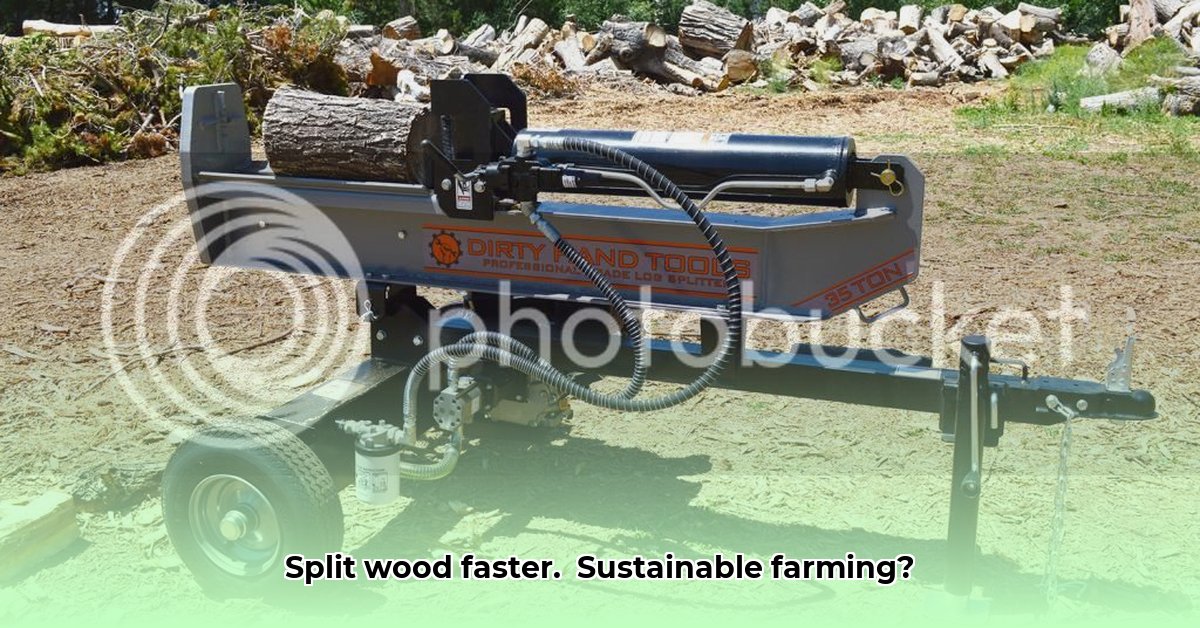
Sustainable Farming and the Power of Manual Labor
Sustainable farming practices are increasingly important, focusing on minimizing environmental impact while maximizing efficiency and profitability. Renewable resources play a crucial role, and wood is a prime example, used for heating, fencing, and land clearing. However, traditional methods often rely on gas-powered equipment, leading to significant emissions. This is where the often-overlooked manual log splitter enters the picture. For additional farm equipment options, check out these tractor implements. This article explores how a manual log splitter, readily available at Tractor Supply and other retailers, can be a valuable tool in building a more sustainable and self-sufficient farm.
Choosing the Right Manual Log Splitter
Selecting the appropriate manual log splitter is crucial for optimal performance and safety. Several key factors influence this decision:
- Splitting Capacity: How much force is required to split the wood you typically handle? Hardwoods require more force than softwoods.
- Wood Dimensions: Measure your average logs to ensure the splitter can comfortably handle them.
- Construction: A robust, well-built splitter made of high-quality steel will withstand years of use.
- Portability: Will you need to move the splitter frequently? Lighter models offer improved maneuverability.
Tractor Supply offers a variety of models; careful comparison is essential before making a purchase.
Safety First: A Critical Aspect
Safety should always be prioritized when using any tool. When operating a manual log splitter, always follow these precautions:
- Protective Gear: Wear safety glasses, heavy-duty work gloves, and sturdy boots.
- Pre-Use Inspection: Inspect the log splitter before each use for any damage or loose parts.
- Proper Technique: Use the correct splitting technique as outlined in the manufacturer's instructions.
- Regular Maintenance: Lubricate moving parts and replace worn components promptly.
“Ignoring safety protocols can lead to serious injuries,” advises Dr. Emily Carter, Agricultural Safety Specialist at the National Farm Safety Institute. “Proper training and consistent adherence to safety practices are paramount”.
Manual vs. Mechanical: A Comparative Analysis
Manual and mechanical log splitters differ significantly in several aspects:
| Feature | Manual Log Splitter | Mechanical Log Splitter |
|---|---|---|
| Initial Cost | Lower | Higher |
| Maintenance | Minimal; primarily lubrication and visual checks | More frequent and potentially expensive repairs |
| Environmental Impact | Significantly lower; zero direct emissions | Higher; emissions and fuel consumption |
| Physical Effort | Demanding; requires considerable strength | Requires less physical exertion |
| Efficiency | Slower splitting rate | Faster splitting rate |
The choice depends on individual needs and priorities. Is the reduction in environmental impact and cost worth the increased physical exertion? This is a key question to consider.
Case Study: Sustainable Farming with Manual Log Splitters
Many farmers successfully integrate manual log splitters into their sustainable farming practices. One example is John Miller, a small-scale organic farmer from Vermont, who uses a manual splitter for preparing firewood and land clearing. "It's more work, but the environmental benefits and cost savings are substantial," he states.
This illustrates how thoughtful planning and a commitment to sustainable practices can yield significant rewards, both environmentally and economically.
Step-by-Step Implementation Guide
Implementing a manual log splitter effectively involves several key steps:
- Assess Your Needs: Determine your average wood volume, type, and size.
- Splitter Selection: Choose a model matching your needs and physical capabilities.
- Workspace Preparation: Ensure a safe, level, and well-lit working area.
- Safety First: Always wear appropriate safety gear.
- Technique Mastery: Develop proper splitting technique for efficiency and injury prevention.
- Ongoing Maintenance: Regularly clean, lubricate, and inspect your log splitter.
Following these steps maximizes safety and ensures the effectiveness of the log splitter. Remember: safety should never be compromised for speed or efficiency.
Expanding Your Sustainable Farming Strategy
The manual log splitter forms a single piece in a much larger puzzle. Sustainable farming necessitates a holistic approach incorporating:
- Soil Health: Implementing practices like cover cropping and no-till farming.
- Water Conservation: Employing techniques like drip irrigation and rainwater harvesting.
- Integrated Pest Management (IPM): Minimizing pesticide use through biological control methods.
- Crop Rotation: Maintaining soil fertility and preventing pest buildup.
By integrating these practices with responsible energy choices, such as using a manual log splitter, you contribute to a truly sustainable farming operation.
Conclusion: A Greener, More Efficient Future
Adopting a manual log splitter offers a practical pathway to a more sustainable farm. While requiring physical effort, the benefits concerning environmental impact, cost-effectiveness, and a more hands-on approach to farming are significant. By making informed choices and integrating this tool within a broader sustainable farming strategy, farmers can effectively reduce their environmental footprint, increase farm resilience, and create a more self-sufficient operation.